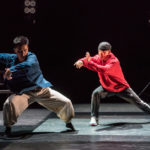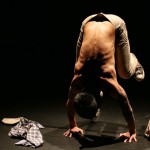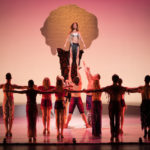Identity. Escapism. The toxicity of romance. These are the big themes that eight young choreographers – four from Hong Kong, four from mainland China – tackled in a March 3-4 showcase of collaborative works under the umbrella of the Hong Kong Arts Festival’s Dance Exchange.
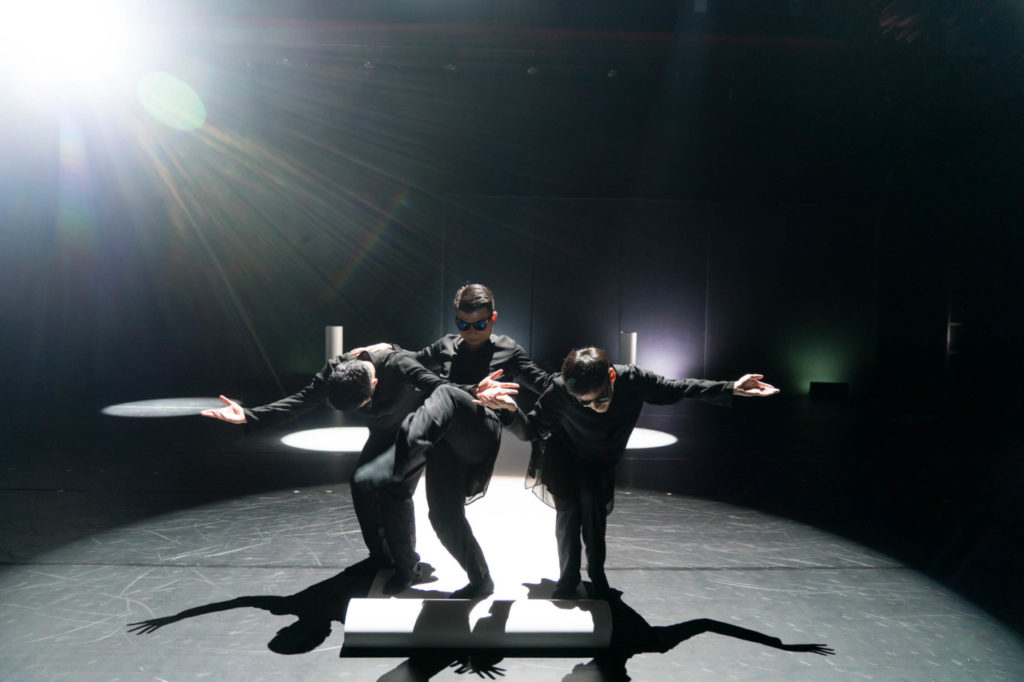
Zhang Yixiang, Pak Wei-ming and Yang Chang in their ‘Pomelo.Orange.Tangerine’ (Photo: Cheung Wai-lok)
The choreographers were split into three groups, which each produced a half-hour work. It was fascinating to witness the visceral connections between the dance-makers, who all performed in their own work, and to imagine the compromises that had to have been hammered out, often over long distances.
30 minutes is an eternity in dance, yet there did not seem to be a superfluous moment in any of the pieces. Of the three, Pomelo.Orange.Tangerine. by Yang Chang, Zhang Yixiang and Pak Wei-ming was the most consistently gripping.
The programme notes that the three young men are the same age. Their piece is packed with ideas about male identity and how men project themselves into the world. The lion’s share of the piece is danced in a uniform of black tunic and trousers that minimizes their physical differences, but it opens and closes with them in their characters’ ‘signature’ wardrobe: Yang in a traditional Chinese women’s robe with his face obscured; Pak barelegged in a short white fur coat and outrageously high heels; and Zhang in today’s regulation ‘cool’ garb of black jacket, T-shirt and jeans.
When they first appear, the men saunter toward the audience like runway models, to the pounding 80’s groove and voice of Madonna singing: “Time goes by so slowly for those who wait / No time to hesitate / Those who run seem to have all the fun / I’m caught up I don’t know what to do.”
In solos, duos and trios, they explore an impressive range of technique, parodic impersonations, and intense and fluid partnering. The spectre of Pina Bausch emerges in surreal antics and in the choice of an evocative track by Jun Miyake, a frequent Bausch collaborator.
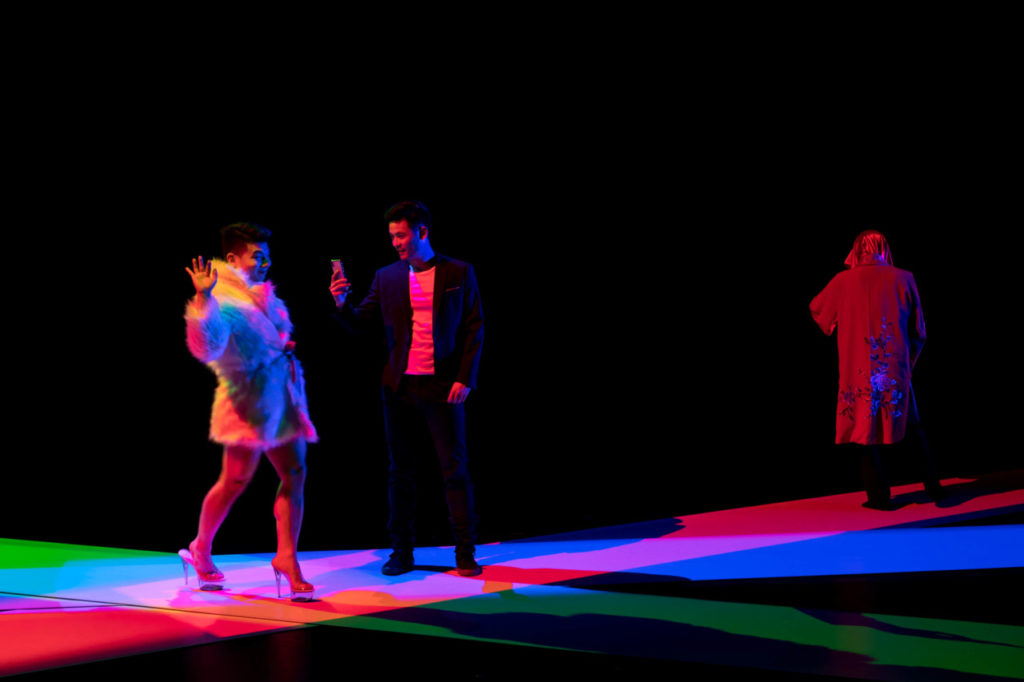
Pak Wei-ming, Zhang Yixiang and Yang Chang in ‘Pomelo.Orange.Tangerine’ (Photo: Cheung Wai-lok)
Extensive use is made of large rolls of white vinyl that the dancers partially unroll onto the stage: these register as fashion runways but also as unfinished roads, dead ends, that seem to frustrate the dancers as they attempt to traverse the stage.
Much is made of the differences in their physiques. Yang’s height, lankiness, and elegant lines are exploited fully in spiraling contemporary work, as well as in a funny and edgy take on the Drunken Imperial Concubine of Beijing opera. Zhang’s more sculpted build combines explosiveness and poetry of movement. Pak’s compact and stocky form makes a great foil to the other two, often used to comic effect, though his powerful and well-controlled technique is also much in evidence.
We are swept up in the dancers’ journey, privy to their yearnings and frustrations. Their differences are wittily symbolized by the trio of citrus fruits displayed like fine sculpture on pedestals at the end of the piece. Ultimately, camaraderie reigns and the final product is a testament to tolerance and mutual support: these young men have each other’s backs.
Pomelo.Orange.Tangerine recalls a quote from a recent interview with Chilean actress Daniela Vega, the transgender lead in the Oscar-winning film, A Fantastic Woman: “I think that creating art comes from a very deep, poetic, and contemplative place, and then the presentation process is such a frivolous one.”
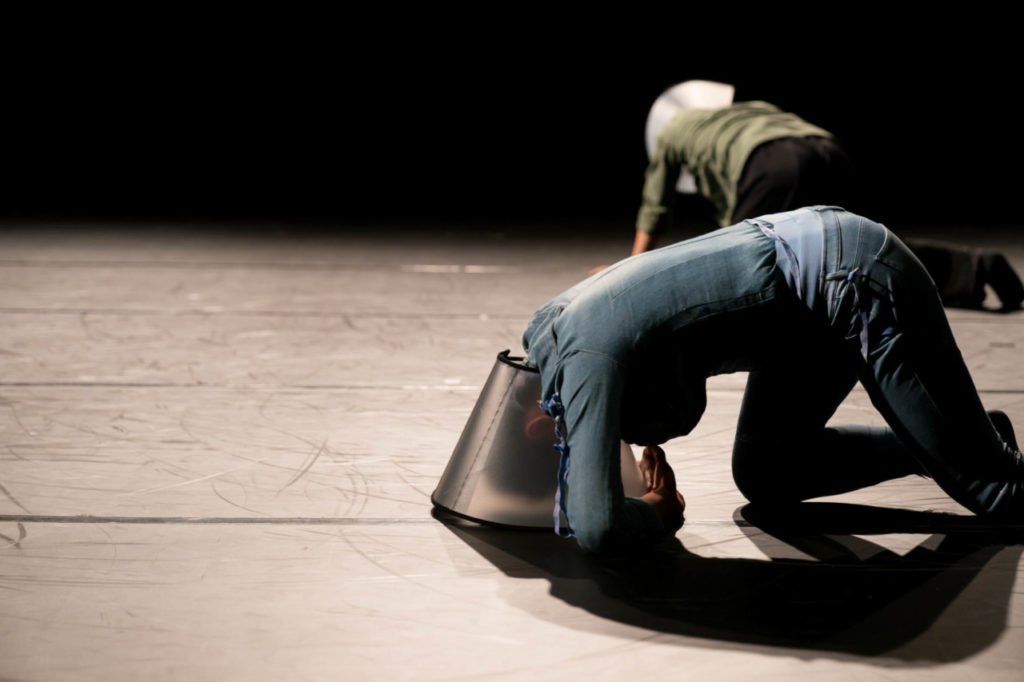
Judy Yiu and Li Chao in Yiu, Chao and Yang Hao’s ‘Fly Me to the Moon’ (Photo: Cheung Wai-lok)
Li Chao, Yang Hao and Judy Yiu gave us Fly Me to the Moon, an enterprise in which three characters, who appear to have nothing in common, embark on a phantasmagoric journey. It’s unclear whether they are disaffected young people looking to escape their unbearable circumstances, or the last three people left on earth after a nuclear disaster – but the vagueness is part of the charm of this piece.
Loneliness pervades. Li engages in a tender and funny pas de deux with an inflated life-size doll, to the recorded accompaniment of Audrey Hepburn singing ‘Moon River.’ Yang strolls onstage and shoots them side-eye before flaunting his moves in a languid but powerful solo that morphs into a parody of rockstardom. Li abandons the doll to waltz with Yang in a dance laced with moves from his duet with the doll. The result is both virtuosic and hilarious.
All three dancers strap plastic cones around their necks for an extended episode. (This is the contraption, often called the “cone of shame,” that is placed around a dog’s neck to prevent it from licking or scratching a wound.) The dancers first crawl around miserably on the floor, rather like abandoned dogs. But once they stand up and make impetuous attempts to escape earth’s gravity, the cone comes to symbolize, in a low-tech manner, an astronaut’s space suit.
When magic happens in dance theater, it is because the memorable elements add up to more than the sum of its parts. That didn’t quite happen here.

(L-R) Poon Chun-ho, Liu Xue, Wang Qi and Xie Xin in Xie and Poon’s ‘..after….’ (Photo: Cheung Wai-lok)
Xie Xin and Poon Chun-ho took us to a very dark place in their work that closed the evening. Titled ..after…., it’s a portrait of the disintegration of an intimate relationship, along a timeline that keeps the audience guessing all the way up to the final blackout.
Right out of the starting gate, Xie comes across as a forceful dancer and dramatic actress; Poon seems more mild-mannered and inclined to lightheartedness. But we see an angry, violent streak emerge in him, shortly after a second couple comes onstage, carrying a dining table and chairs.
At first, I think this insouciant couple represents Xie and Poon in earlier days, or their alter egos. But once the two couples interact, that idea no longer holds up.
Poon appears to have a fling with the other woman, danced by Wang Qi. Things start to go downhill fast. But it’s not a straightforward narrative of betrayal and jealousy.
The two women don men’s jackets and dance a side-by-side duet of newfound fortitude. Meanwhile, Poon and his counterpart, Liu Xue, listlessly contemplate a pair of women’s cocktail dresses on hangers, drape them on chairs and dance with the chairs. All four enter into a highly charged confrontation. The women wrap their legs around the men’s necks as the men spin them wildly. The quartet is a tour de force, with waves of emotion coursing through the dancers’ bodies like electricity, rendering them almost inhuman. On the ominous, throbbing soundtrack we hear heavy breathing, glass breaking, distant voices in agony.
Poon, however, keeps breaking away. He speaks to us as if disoriented, at one point saying, “I don’t know where your woman is.”
Toward the end, an utterly spent Xie drips hot candle wax onto the back of her hand. Alarmed, we are still not sure how this thing is going to end. Poon returns, and they embrace. On the soundtrack, the innocuous voice of Ed Sheeran assures us “Oh, I never knew you were the someone waiting for me / ‘Cause we were just kids when we fell in love / Not knowing what it was …” But things keep unraveling.
This portrayal of the destructive force of romance was original and mesmerizing, and the performances daring. But some vital connections seemed to be missing – between the characters, and in transitions between scenes.

Xie Xin (foreground), Poon Chun-ho and Wang Qi (background) in Xie and Poon’s ‘..after….’ (Photo: Cheung Wai-lok)
Dance collaborations are inevitably tricky – even trickier with the mainland/Hong Kong dynamic in the mix. Yet all of these participants articulated a shared artistic vision, surmounting differences in background, creative process and artistic sensibility. In a region where support for independent dance-makers is slim, these opportunities are golden.
– The Hong Kong Jockey Club Contemporary Dance Series continues at the Hong Kong Arts Festival through Mar. 25, 2018, with one more mixed program that features more local choreographers. Click here for information and tickets. –

